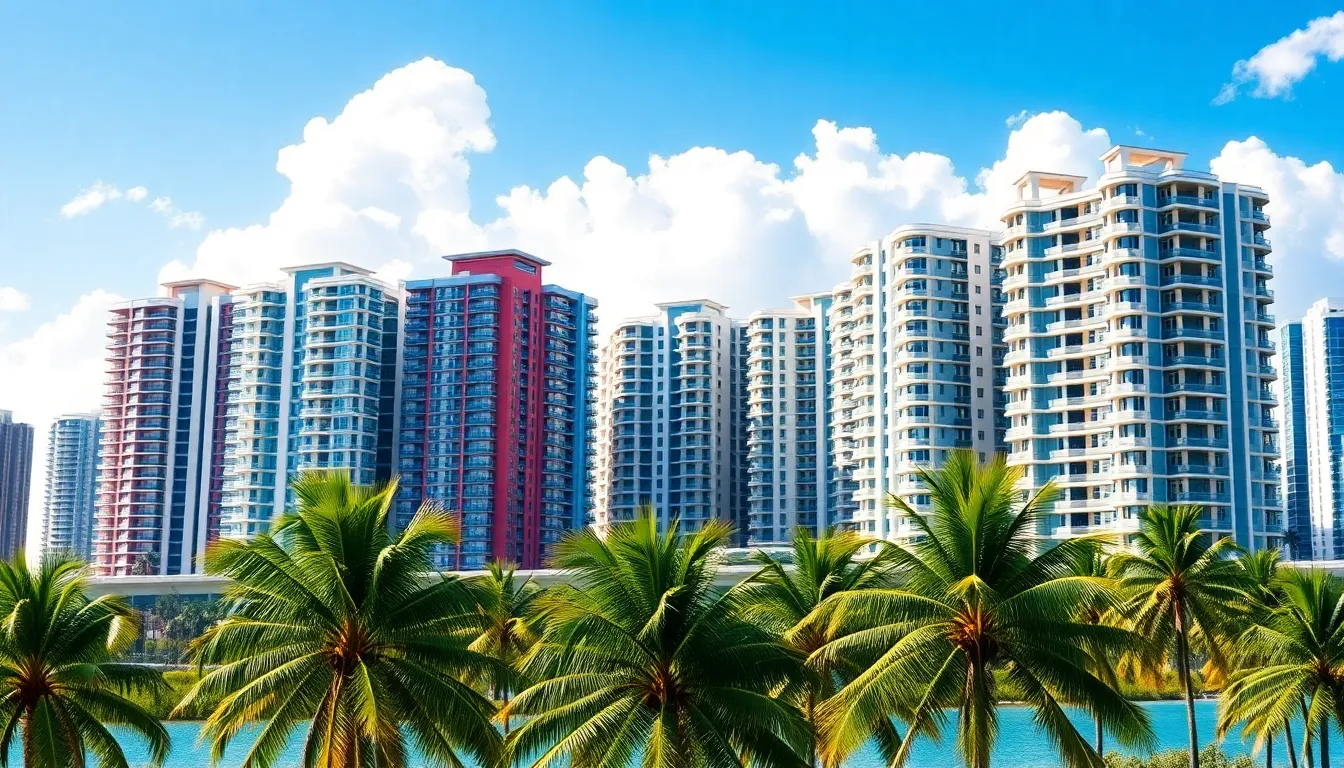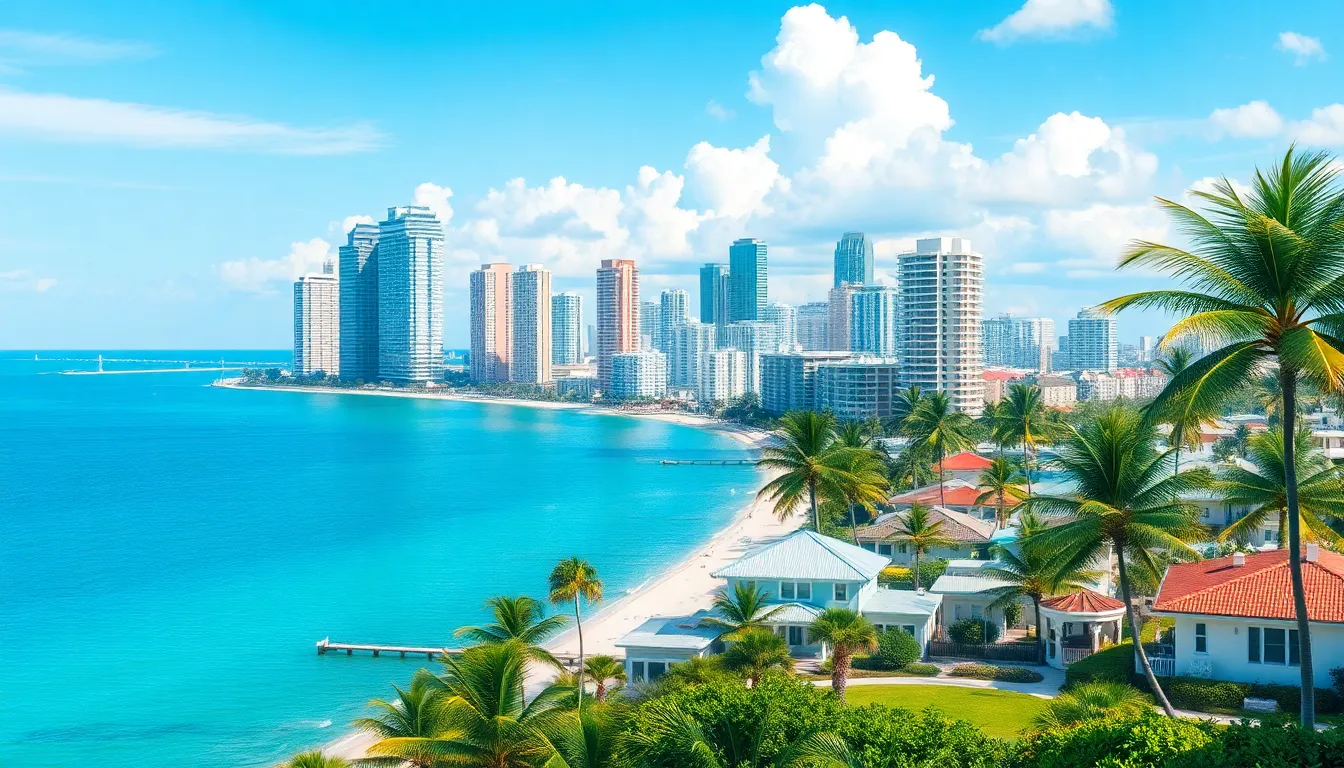Miami’s real estate market isn’t just hot; it’s sizzling like a beachside barbecue in July. With its stunning coastline and vibrant culture, it’s no wonder people are flocking to this sunny paradise. But what’s really cooking in the Miami real estate scene? From luxury condos that make you feel like a celebrity to charming bungalows perfect for weekend getaways, the trends are as diverse as the city itself.
As the market evolves, savvy buyers and investors need to stay ahead of the curve. Whether it’s the rise of eco-friendly homes or the increasing demand for waterfront properties, understanding these trends can make all the difference. So grab your shades and prepare to dive into the latest insights that’ll have you navigating Miami’s real estate waters like a pro.
Table of Contents
ToggleOverview of Miami Real Estate Trends
Miami’s real estate market shows remarkable growth, driven by a surge in demand for properties. Recent data indicates an increase in home prices, with the median sale price reaching around $500,000, reflecting a 10% year-over-year rise. Investors recognize the potential for high returns, especially with luxury condominiums and waterfront properties in high demand.
Changing buyer preferences influence the market landscape. Eco-friendly homes attract attention as many seek sustainable living options. Buyers increasingly favor amenities that enhance lifestyle, such as fitness centers, pools, and proximity to waterfronts.
In addition, recent developments in Miami’s neighborhoods impact property values. Areas like Wynwood and the Design District experience revitalization, making these locales appealing for both residential and commercial investment. Condos near the beach and downtown urban spaces cater to diverse buyer demographics, from young professionals to retirees.
Market trends also reveal a growing interest in rental properties. Investors prioritize income-generating assets, especially short-term rentals catering to tourists. The demand for such properties has risen significantly, supported by Miami’s status as a top travel destination.
Current statistics emphasize the need for buyers and investors to remain vigilant. Tracking shifts in inventory, which saw a 15% decline in available homes in the last quarter, is crucial. All these factors contribute to an evolving Miami real estate environment ripe with opportunities.
Current Market Analysis

Miami’s real estate market continues to thrive, showcasing strong performance indicators. Recent statistics provide essential insights into price trends and inventory levels.
Price Trends
Median sale prices now hover around $500,000, reflecting a significant 10% increase compared to last year. Luxury condominiums and waterfront properties see heightened demand, pushing prices higher. Buyers gravitate toward eco-friendly homes, which often command premium rates. Investors should monitor these trends closely, as the evolving landscape influences future pricing. With many properties featuring modern amenities, competition intensifies, leading to swift sales.
Inventory Levels
Current data indicates a 15% decline in available homes over the last quarter. This decrease poses challenges for buyers, as fewer options may prolong decision-making. Areas experiencing revitalization, such as Wynwood and the Design District, encounter especially low inventory. Rental properties, particularly short-term options, also reflect increasing demand in this tight market. Staying informed about these changes remains crucial for both buyers and investors aiming to capitalize on Miami’s dynamic landscape.
Key Factors Influencing Trends
Multiple factors shape the dynamics of Miami’s real estate market, affecting buyer behavior and property values alike. Understanding these influences helps navigate the evolving landscape effectively.
Economic Influences
Strong economic indicators significantly impact Miami’s real estate market. The local economy benefits from tourism, international investment, and a diverse job market, enhancing demand for properties. Recent data shows that low unemployment rates have helped maintain buyer confidence. As financial conditions strengthen, demand for luxury condominiums and waterfront properties rises, often driving prices upward. Additionally, increased interest rates may challenge affordability, prompting buyers to adjust their targets. Price adjustments keep the market competitive while influencing property investment strategies.
Demographic Shifts
Shifting demographics play a crucial role in shaping real estate trends. Miami’s population continues to grow, primarily due to young professionals and retirees relocating for a favorable climate and lifestyle. Urban areas like Wynwood and the Design District attract cultural enthusiasts and entrepreneurs, leading to increased property interest. Furthermore, the rise of remote work has motivated buyers to seek larger living spaces outside urban centers. These new buyers often prioritize sustainable living options, contributing to the demand for eco-friendly properties. Understanding demographics aids investors in targeting properties that align with current market preferences.
Popular Neighborhoods in Miami
Miami features a diverse array of neighborhoods, each with unique characteristics appealing to various buyers and investors. Current trends highlight both emerging areas and established hotspots.
Emerging Areas
Wynwood continues to attract attention, renowned for its vibrant street art and cultural scene. The Design District showcases luxury retail, drawing in affluent residents and investors alike. Little Haiti has experienced revitalization, making it appealing for those seeking a culturally rich community. Data indicates these neighborhoods have seen significant property appreciation, with some areas noting increases above 20% year-over-year. Short-term rental demand drives interest in these locales, as tourists flock to the creative and dynamic environments.
Established Hotspots
South Beach remains an iconic destination, attracting buyers interested in luxury condos and beachfront properties. Its nightlife and dining scene contribute to a high demand, reflected in median prices exceeding $800,000. Brickell, often dubbed the financial district, attracts young professionals drawn to its bustling urban lifestyle. Properties here routinely appreciate at rates above 10%. Coral Gables features historic charm, appealing to families seeking larger living spaces with excellent schools. Increased investment in these established neighborhoods continues influencing Miami’s market trajectory and attracting a diverse range of buyers.
Future Predictions for Miami Real Estate
Predictions indicate continued growth in Miami’s real estate market. Analysts expect prices for luxury properties, especially waterfront condominiums, to rise due to sustained demand. Recent trends show a preference for eco-friendly homes, which are likely to become even more popular as buyers prioritize sustainability.
Developments in neighborhoods like Wynwood and the Design District signal a shift toward urban living and investment opportunities. Property appreciation in these areas has accelerated, attributed to cultural vibrancy and short-term rental demand. Statistics confirm that rental markets are expanding, with Miami remaining a sought-after destination for tourists and remote workers alike.
Rising interest rates might pose affordability challenges. Despite these potential hurdles, buyer confidence remains strong due to low unemployment rates and a robust job market. Demographic shifts toward younger professionals and retirees are reshaping preferences, leading many to seek larger living spaces or accommodations with eco-friendly features.
Local experts highlight that the current inventory decline may spur bidding wars on available properties. As the supply of homes decreases by 15% over the last quarter, buyers face increased competition. Active investors and homebuyers must adapt quickly to these evolving conditions to secure desirable properties.
Overall, understanding these dynamics provides valuable insights into Miami’s future real estate landscape. Emerging trends and ongoing economic factors continue to influence purchasing decisions, shaping a vibrant and competitive market.
Miami’s real estate market is poised for continued growth and transformation. With rising demand for luxury properties and eco-friendly homes buyers are navigating a competitive landscape. The revitalization of neighborhoods and the increasing appeal of rental options further enhance investment opportunities.
As the market evolves staying informed about trends and shifts is essential for both buyers and investors. The current inventory challenges may create urgency but the vibrant culture and economic stability of Miami remain strong draws. Embracing these dynamics will be key to thriving in this dynamic real estate environment.







